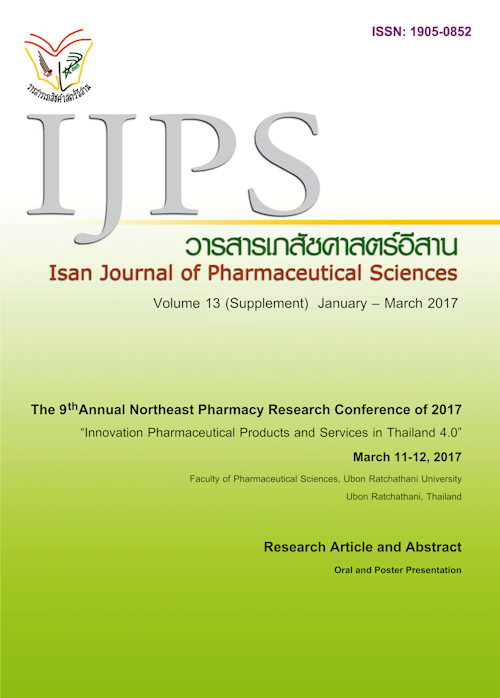Impacts of Drug Use Control Measures on Utilization and Expenditure of Non-National Essential Statins in A Provincial Hospital
Main Article Content
Abstract
Introduction: Expenditures of non-national essential drug use in civil servant medical benefit scheme (CSMBS) outpatients increase every year and several drug use control measures have been introduced to control the use and expenditures of these drugs in hospital settings. The objectives of this study are to determine impacts of the measures on utilization and expenditures of statins in a provincial hospital. Methods: Data were retrospectively collected from electronic databases of CSMBS outpatients who were prescribed statins (either non-essential drugs (NED) or essential drugs (ED)) during fiscal year 2010-2014 in one provincial hospital. Utilization was measured as number of prescriptions and medication supply days, medication procession ratio (MPR) and patterns and ratios of ED and NED use, and expenditure as baht/month or baht/year. Segmented regression was applied for time-series analysis to estimate impacts of the measures on statins utilization and expenditures. Results: During 2010-2014, numbers of CSMBS outpatients using statins increased and ratios of the ED/NED statins used patients rose from 0.84 in 2010 to 2.87 in 2014. From 2010 to 2014, the total use of all statins increased but quantity of NED statins use declined (5.27 to 3.10 thousand prescriptions and 366 to 234 medication supply days, respectively). The expenditure of NED statins declined from 14.2 to 6.13 million baht and the total expenditure of all statins decreased from 16.78 to 9.79 million baht. Proportions of the MPR greater than 1 slightly increased from 45.0% to 46.9%. The regression analysis revealed that all measures implemented in the studied hospital were statistically associated with reduction in NED statins utilization and expenditure. Conclusion: The findings from the study provincial hospital illustrate that drug use control measures have significant impacts on statins utilization and reduce drug expenditure to the hospital.
Article Details
In the case that some parts are used by others The author must Confirm that obtaining permission to use some of the original authors. And must attach evidence That the permission has been included
References
Chaiyakunapruk N, Tanakornrungrod A, Cheewasithirungrueng N, et al. Estimation of financial burden due to
oversupply of medication for chronic disease. Asia Pacific Journal of Public Health. 2012 May; 24(3): 487-94.
Chaiyasong S, Chaiyasong C. Impacts of Esomeprazole Injection Control Policy on Utilization and Expenditure in Mahasarakham Hospital. Isan Journal of Pharmaceutical Sciences. 2014 Sep 2; 10(2): 161-172.
Dilokthornsakul P, Chaiyakunapruk N, Nimpitakpong P. Effects of Direct Billing System on Prescribing Patterns in the Civil Servant Medical Benefit Scheme. Journal of Health Systems Research. 2010; 4: 53-62.
Health Systems Research Institute. HSRI Forum: Moving forward to control the drug costs in Civil servant medical benefit Schemes. Journal of Health Systems Research. 2012; 5(1): 1-11.
Jindapol N, Kunupatham P, Theerasilp P, Kitikannakorn N. Crisis of Health Insurance under Thai Civil Servant Medical Benefit Scheme (CSMBS). Srinagarind Medical Journal. 2014; 29(2): 199-206.
Lagarde M. How to do (or not to do). Assessing the impact of a policy change with routine longitudinal data. HealthPolicy Plan. 2012; 27: 76-83.
Limwattananon C, Thammatacharee N, Waleekhachonloet O, et al. Expenditure of Civil Servant Medical Benefit Scheme and the use of non-essential medicines. Journal of Health Systems Research. 2011; 5(2): 149-159.
Limwattananon C, Sooksai N, Topark-Ngarm A, et al. Measures to promote rational use of medicines in public hospitals: a review and analysis of national policy interventions. Journal of Health Systems Research. 2013; 7(1): 33-44.
Tharat N, Limwattananon C, Sakolchai S, Waleekhachonloet O, Soontornpas C. Monitoring and Evaluating the implementation of Non-essential drug prescription criteria measure at a Provincial Hospital in Thailand. Journal of Health Systems Research. 2014; 8(3): 221-229.


